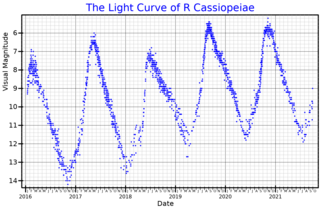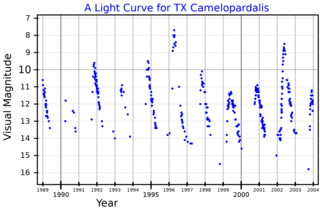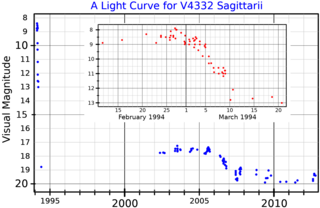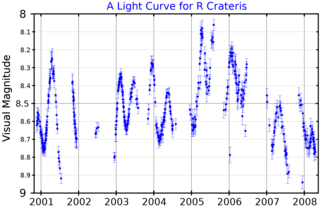
The asymptotic giant branch (AGB) is a region of the Hertzsprung–Russell diagram populated by evolved cool luminous stars. This is a period of stellar evolution undertaken by all low- to intermediate-mass stars (about 0.5 to 8 solar masses) late in their lives.

Tau Sagittarii is a star in the southern zodiac constellation of Sagittarius.

X Sagittarii is a variable star and candidate binary star system in the southern constellation of Sagittarius, near the western constellation boundary with Ophiuchus. It has a yellow-white hue and is visible to the naked eye with an apparent visual magnitude that fluctuates around 4.54. The star is located at a distance of approximately 950 light years from the Sun based on parallax, and is drifting closer with a radial velocity of −10 km/s. The star has an absolute magnitude of around −2.85.

R Cassiopeiae is a variable star in the northern constellation of Cassiopeia. It is located approximately 574 light years distant from the Sun, but is drifting closer with a radial velocity of −23 km/s. This is a pulsating Mira-type variable star with a brightness varies from magnitude +4.4 down to +13.5 with a period of 433.6 days. At its maximum, R Cassiopeiae is visible to the naked eye as a faint, red-hued star.
KW Sagittarii is a red supergiant star, located approximately 2,160 parsecs away from the Sun in the direction of the constellation Sagittarius. It is one of the largest known stars, with a diameter about 1,000 times larger than the Sun. If placed at the center of the Solar System, the star's surface would engulf Mars, coming close to Jupiter's orbit.

V725 Sagittarii is a variable star in the southern constellation of Sagittarius. As recently as a century ago, it was a Population II Cepheid; its transformation was documented by Henrietta Swope beginning in 1937, and is one of the most exciting and instructive events in variable-star astronomy. The star has varied between apparent visual magnitude 12.3 and 14.3.

S Persei is a red supergiant or hypergiant located near the Double Cluster in Perseus, north of the cluster NGC 869. It is a member of the Perseus OB1 association and one of the largest known stars. If placed in the Solar System, its photosphere would engulf the orbit of Jupiter. It is also a semiregular variable, a star whose variations are less regular than those of Mira variables.

TX Camelopardalis is a Mira-type variable star in the constellation Camelopardalis. It is a classical long period variable star with pulsational period of 558.7 days. Water masers have been observed around the star.

V4381 Sagittarii is a variable star in the constellation Sagittarius. A white supergiant of spectral type A2/A3Iab, it is an Alpha Cygni variable that varies between apparent photographic magnitudes 6.57 and 6.62. Its visual apparent magnitude is about 6.54.

An OH/IR star is an asymptotic giant branch (AGB) or a red supergiant or hypergiant star that shows strong OH maser emission and is unusually bright at near-infrared wavelengths.

NML Cygni or V1489 Cygni is a red hypergiant or red supergiant (RSG) in the constellation Cygnus. It is possibly one of the largest known stars currently known, and is also possibly one of the most luminous and massive cool hypergiants, as well as one of the most luminous stars in the Milky Way.

RY Sagittarii is a yellow supergiant and an R Coronae Borealis type variable star in the constellation Sagittarius. Although it ostensibly has the spectrum of a G-type star, it differs markedly from most in that it has almost no hydrogen and much carbon.
AH Scorpii is a red supergiant variable star located in the constellation Scorpius. It is one of the largest stars known by radius and is also one of the most luminous red supergiant stars in the Milky Way.

XX Persei is a semiregular variable red supergiant star in the constellation Perseus, between the Double Cluster and the border with Andromeda.

V4332 Sagittarii is a nova-like event in the constellation of Sagittarius. It was discovered February 24, 1994 at an apparent visual magnitude of 8.9 by Japanese amateur astronomer Minoru Yamamoto from Okazaki, Aichi, then confirmed by K. Hirosawa. Initially designated Nova Sagittarii 1994 #1, it was given the variable star designation V4332 Sgr. A spectra of the event taken March 4 lacked the characteristic features of a classical nova, with the only emission lines being of the Balmer series. Subsequent spectra showed a rapid decline in luminosity and a change of spectral type over a period of five days. By 2003, the object was ~1500 times less luminous than at peak magnitude and showed a spectrum of an M-type star.

RT Virginis is a variable star in the equatorial constellation of Virgo, abbreviated RT Vir. It ranges in brightness from an apparent visual magnitude of 7.7 down to 9.7, which is too faint to be visible to the naked eye. Based on parallax measurements made with the VLBI, the distance to this star is approximately 740 light years. It is receding from the Sun with a radial velocity of 17 km/s.

U Sagittarii is a variable star in the southern constellation of Sagittarius, abbreviated U Sgr. It is a classical Cepheid variable that ranges in brightness from an apparent visual magnitude of 6.28 down to 7.15, with a pulsation period of 6.745226 days. At its brightest, this star is dimly visible to the naked eye. The distance to this star is approximately 2,080 light years based on parallax measurements, and it is drifting further away with a radial velocity of 2 km/s.

R Crateris is a star about 700 light years from the Earth in the constellation Crater. It is a semiregular variable star, ranging in brightness from magnitude 8.1 to 9.5 over a period of about 160 days. It is not visible to the naked-eye, but can be seen with a small telescope, or binoculars. R Crateris is a double star; the variable star and its magnitude 9.9 F8V companion are separated by 65.4 arcseconds.

V356 Sagittarii is an eclipsing binary star system in the southern constellation of Sagittarius, abbreviated V356 Sgr. It has a peak apparent visual magnitude of 6.84, which decreases to 7.66 during the primary eclipse and 7.24 with the secondary eclipse. Based on parallax measurements, this system is located at a distance of approximately 2,210 light years from the Sun.















